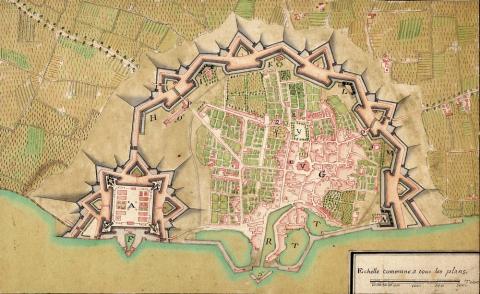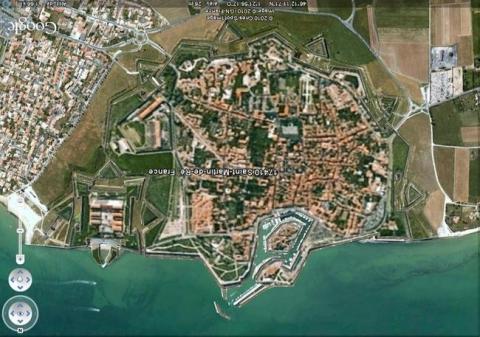Saint-Martin-de-Ré
History and description
Main agglomeration of the île de Ré, Saint-Martin-de-Ré was founded in 737 with the creation of the abbaye Notre Dame. Taken by France for the first time under Louis VII in 1224, it was only definitively attached to the kingdom under Charles VII in 1457 and became a strategic spot of French marine defence against the English and against the Protestants of La Rochelle. The first modern fortifications were built under Louis XIII to replace a urban medieval wall razed to the ground in 1622. In 1625, the engineer d’Argencourt, head of the fortifications of Aunis, Poitou, Saintonge and Guyenne designed the first citadel, the first fort de la Prée and a first tower in Sablanceaux. This project was accepted by the King and implemented by the Marshal de Thoiras. The citadel was a bastioned square fort but remained incomplete when the English took over the isle in 1627, coming to the assistance of the besieged inhabitants of La Rochelle. The two citadels resisted up to the point of capture of the Isle by the French army but were threatened. br /> In 1672, the engineer La Favollière designed a project involving an urban wall and a port. This project was not applied but the engineer Francis Ferry included some elements thereof in 1681. Vauban was sent to the isle in 1674. Later, Ferry, who was still on-site, designed the project that Vauban approved and which involved constructing a second citadel on the emplacement of the first. This citadel was square, with four arrow-headed bastions, three ravelins on the earth fronts, and a fourth dug ravelin, which served as a mooring point on the sea front, dry moats and large glacis, a single gate on the sea front. It also involved reconstructing the urban wall in the form of a semi-circle including five fronts, five arrow-headed bastions, five ravelins, a semi-bastion with an inner fortified structure on the sea front, glacis and two gates, to the south-west and south-east. The urban wall was connected to the citadel and extended over an area wider than the town itself. The expansion did not get underway because there was a need for free sites to be used to set up reception camps for the other habitants of the île de Ré, as well as their cattle and their harvest, in case of invasion. The construction continued up until 1685. The addition of external works planned by Vauban in 1684 was not carried out.Under the Third Republic, the urban wall of the town was slightly modified to accommodate sheltering passages adapted to rifled artillery. Apart from that, the aspect of the urban wall has remained unchanged since 1685.
Current state
The urban wall has been completely preserved. Only one of the gates, that of the south-west, has lost its superstructure, demolished in order to enlarge the passage. The ramparts of the citadel have also been preserved. Of the internal buildings, all that remains are the bastion tunnels, the lodge of officials near the gate, the chapel, the arsenal and a barracks. The other buildings were replaced by those of the modern prison which still occupies the site. Accordingly, only the ramparts, transformed into a city park and the small port of the citadel are open to visitors. The site is included on the World Heritage List as part of the fortifications of Vauban. The relief map to a scale of 1/600, constructed in 1703 and restored in 1771, has survived and is preserved at the musée des Plans Reliefs (museum of Relief Maps) in Paris.
Saint-Martin-de-Ré
Saint-Martin-de-Ré
46° 11' 55.4816" N, -1° 23' 20.1188" E
Type
citadel and urban wall
Department
Charente-Maritime
Region
Nouvelle-Aquitaine
Bibliography
- BARTHON (C.), L’île de Ré, histoire et géographie contemporaine, Plomelin, 2005.
- BERRIAUX (Y.), Promenade à travers les fortifications de Saint-Martin-de-Ré, Sainte-Marie-de-Ré, 2002.
- BONNEL (E.), « Fortifications de Saint-Martin-de-Ré, les orgues des portes » in Bulletin des Amis de l’Île de Ré, n°47, février 1973, p. 42-50.
- DAVID (M.), « Ré sentinelle avancée sur la frontière maritime » in Cahiers de la Mémoire : revue d’art et tradition populaire, d’archéologie et d’histoire, n°19, 1985.
- FAUCHERRE (N.), PROST (P.), Les fortifications du littoral : la Charente-Maritime, Chaunay, 2000.
- JAMBUT (M.), Le pénitencier de Saint-Martin-de-Ré de 1685 à nos jours, Chaunay, 1998.
- LE BLANC (F Y), FAUCHERRE (N.), La route des fortifications en Atlantique. Paris, 2007.
- MONGIN (M.), STEENBERGEN (M.), Saint-Martin-de-Ré, place forte insulaire, Woippy, 2015.
- WARMOES (I.), Le Musée des Plans-Reliefs, Paris, 1997, p.60.

